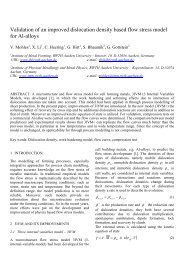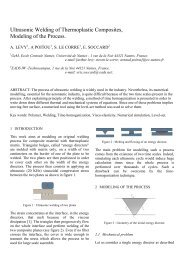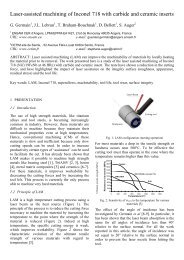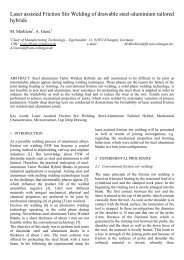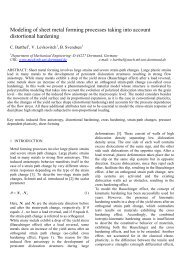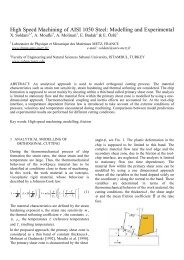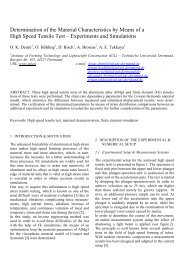bending test of composite reinforcements - ResearchGate
bending test of composite reinforcements - ResearchGate
bending test of composite reinforcements - ResearchGate
You also want an ePaper? Increase the reach of your titles
YUMPU automatically turns print PDFs into web optimized ePapers that Google loves.
width. KES <strong>test</strong>s have been performed at ENSISA<br />
<strong>of</strong> Mulhouse. One can notice a good correlation between<br />
both <strong>test</strong>s. This comparison allows to validate<br />
the flexometer.<br />
Figure 3: Moment computing<br />
For each length <strong>of</strong> <strong>bending</strong> <strong>test</strong>, momentcurvature<br />
graph can be drawn. If the set <strong>of</strong> graphs are<br />
superposed, the behaviour is elastic and the momentcurvature<br />
graph for the greater length enables to define<br />
a <strong>bending</strong> model. If not, for each length <strong>of</strong><br />
<strong>bending</strong> <strong>test</strong>, the moment and the curvature computed<br />
at embedding point enable to draw a point on the<br />
moment-curvature load graph.<br />
3.3 Test and validation<br />
Tests have been performed on a 2.5D carbon woven<br />
reinforcement and compared with KES results (fig.<br />
4). The sample is 0.62 mm thick and its weigth is<br />
630 g/m 2 . For the flexometer it was 50 mm width<br />
and 300 mm long.<br />
M (N.mm /mm)<br />
0.09<br />
0.08<br />
0.07<br />
0.06<br />
0.05<br />
0.04<br />
0.03<br />
0.02<br />
0.01<br />
M=f(K)<br />
Flexo vs KES<br />
0.00<br />
0.00 0.01 0.02 0.03 0.04 0.05 0.06<br />
K (mm−1)<br />
Figure 4: Flexometer results vs KES<br />
For the KES-FB, it has been reduced to 30 mm<br />
Flexo<br />
KES<br />
4<br />
4 CONCLUSIONS<br />
The fabric <strong>bending</strong> behaviour is a complex multiscale<br />
mechanical problem and it is not possible to predict<br />
accuratly the <strong>bending</strong> behaviour from only the yarns<br />
properties with the present analytical models . At<br />
macroscopic scale <strong>bending</strong> behaviour is described by<br />
the constitutive moment curvature relationship which<br />
is not linear . Because standard <strong>bending</strong> <strong>test</strong>s for<br />
fabrics are not adequate, a new cantilever <strong>test</strong> has<br />
been disigned. Tests performed on a carbon woven<br />
reinforcement have allowed to validate this new <strong>test</strong><br />
and the direct method. Therefore, the direct method<br />
doesn’t able to define unload behaviour because <strong>of</strong> the<br />
difficulty to compute with good accurate the low curvatures.<br />
Thereby the second approach based on an<br />
inverse method will be investigated in the next step.<br />
ACKNOWLEDGEMENT<br />
All our thanks to Laurence Schacher <strong>of</strong> the Laboratoire de<br />
Physique et Mécanique Textiles de Mulhouse ( ENSISA) to have<br />
allowed us to perform the KES <strong>bending</strong> <strong>test</strong>s.<br />
REFERENCES<br />
[1] P Boisse, B Zouari, and JL Daniel. Importance <strong>of</strong> in-plane<br />
shear rigidity in finite element analyses <strong>of</strong> woven fabric<br />
<strong>composite</strong> preforming. Composites Part A: Applied Science<br />
and Manufacturing, 37:2201–2212, December 2006.<br />
[2] Jinhuo Wang, Andrew C. Long, Michael J. Clifford, and<br />
Hua Lin. Energy analysis <strong>of</strong> reinforcement deformations<br />
during viscous textile <strong>composite</strong> forming. In Elias Cueto<br />
and Francisco Chinesta, editors, AIP Conference Proceedings,<br />
volume 907, pages 1098–1106. AIP, 2007.<br />
[3] TK Ghosh, SK Batr, and RL Barke. The <strong>bending</strong> behaviour<br />
<strong>of</strong> plain-woven fabrics. part i : A critical review. The Journal<br />
<strong>of</strong> the Textile Institute, 81:245–254, 1990.<br />
[4] WR Yu, M Zampaloni, F Pourboghrat, K Chung, and<br />
TJ Kang. Analysis og flexible <strong>bending</strong> bahavior <strong>of</strong> woven<br />
preform using non-orthogonal constitutive equation. Composite<br />
Part A : Applied science and manufacturing, 36<br />
(6):839–850, 2005.<br />
[5] FT Peirce. The ’handle’ <strong>of</strong> cloth as a measurable quantity.<br />
The Journal <strong>of</strong> the Textile Institute, 21:377–416, 1930.<br />
[6] ASTM. Standard Test Method for Stiffness <strong>of</strong> fabrics, chapter<br />
D1388-96(2002). American Society for Testing and Materials,<br />
2002.<br />
[7] ISO. Textiles glass -Woven fabrics - Determination <strong>of</strong> conventional<br />
flexural stifness - Fixed angle flexometer method,<br />
chapter iSO 4604:1978. ISO, 1978.



